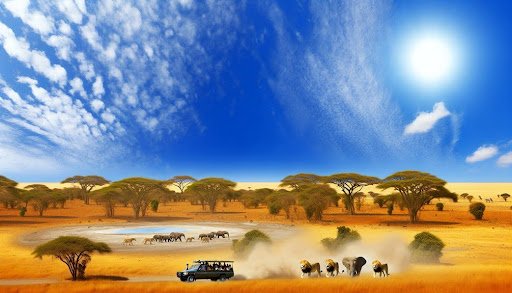Africa’s premier safari destinations offer distinct adventures for thrill-seekers. The Serengeti and Masai Mara showcase the epic Great Migration, while Botswana’s Okavango Delta presents a unique water wilderness experience. South Africa’s Kruger National Park delivers exceptional Big Five encounters, and Tanzania’s Ngorongoro Crater serves as nature’s perfect amphitheater for wildlife viewing. Each destination features its own blend of spectacular landscapes, diverse wildlife, and authentic cultural experiences that await exploration.
The Serengeti National Park: Witness the Great Migration
Located in northern Tanzania, the Serengeti National Park stands as one of Africa’s most iconic wildlife sanctuaries, where the annual Great Migration unfolds across its vast savanna plains.
Each year, over two million wildebeest herds, accompanied by zebras and gazelles, traverse the landscape in search of fresh grazing grounds. This spectacle draws wildlife enthusiasts worldwide, offering unparalleled opportunities for predator sightings as lions, cheetahs, and crocodiles pursue their prey.
The migration follows a clockwise pattern, reaching its peak between June and September when the herds cross the treacherous Mara River.
Okavango Delta: Botswana’s Water Wilderness Safari
Stretching across northwestern Botswana, the Okavango Delta transforms 15,000 square kilometers of arid Kalahari Desert into a lush wetland paradise each year when seasonal floods arrive from the Angolan highlands.
This unique ecosystem features varied terrain of papyrus-lined waterways, grassy floodplains, and forested islands. Visitors navigate the delta’s channels by traditional mokoro canoes, encountering hippos, crocodiles, and elephants.
The region supports abundant birdlife, including African fish eagles, lilac-breasted rollers, and wattled cranes.
Safari lodges, ranging from luxury camps to rustic outposts, offer water-based game viewing, walking safaris, and night drives to observe nocturnal species in this UNESCO World Heritage site.
Kruger National Park: South Africa’s Premier Big Five Experience
While Botswana’s Okavango Delta offers extraordinary water-based safaris, South Africa’s Kruger National Park stands as one of Africa’s most iconic wildlife sanctuaries, encompassing nearly 2 million hectares of pristine wilderness.
The park’s diverse habitats, from savanna grasslands to riverine forests, support over 147 mammal species, including the legendary Big Five: lion, leopard, elephant, rhino, and buffalo. Visitors can explore through guided game drives, walking safaris, and cultural interactions with local communities.
Kruger’s extensive network of roads and accommodations, ranging from luxury lodges to self-catering camps, makes wildlife viewing accessible year-round, with peak game viewing during the dry winter months.
Masai Mara: Kenya’s Wildlife Spectacle
Famous for hosting the Great Migration, Kenya’s Masai Mara National Reserve represents the northern extension of Tanzania’s Serengeti ecosystem, where over two million wildebeest, zebras, and gazelles make their annual pilgrimage.
The reserve’s scenic landscapes include rolling savannas, acacia woodlands, and winding rivers, creating ideal habitats for lions, leopards, elephants, and rhinoceros. Beyond wildlife viewing, visitors immerse themselves in cultural experiences through visits to traditional Maasai villages, where warriors perform ancient dances and share their pastoral lifestyle.
Game drives at dawn reveal predators on the hunt, while hot air balloon safaris offer breathtaking aerial views of the vast plains below.
Ngorongoro Crater: Tanzania’s Natural Amphitheater Safari
The majestic Ngorongoro Crater, a UNESCO World Heritage site, stands as the world’s largest intact volcanic caldera, spanning over 100 square miles of diverse terrain. Its steep walls create a natural enclosure that harbors one of Africa’s densest populations of diverse wildlife, including endangered black rhinos, lions, elephants, and flamingos.
The crater floor presents stunning landscapes that shift from grasslands and swamps to acacia woodlands and soda lakes. This natural amphitheater allows visitors to witness predator-prey interactions and observe the ancient Maasai people who still graze their cattle alongside wild animals, creating a unique ecosystem where nature and culture intersect.








